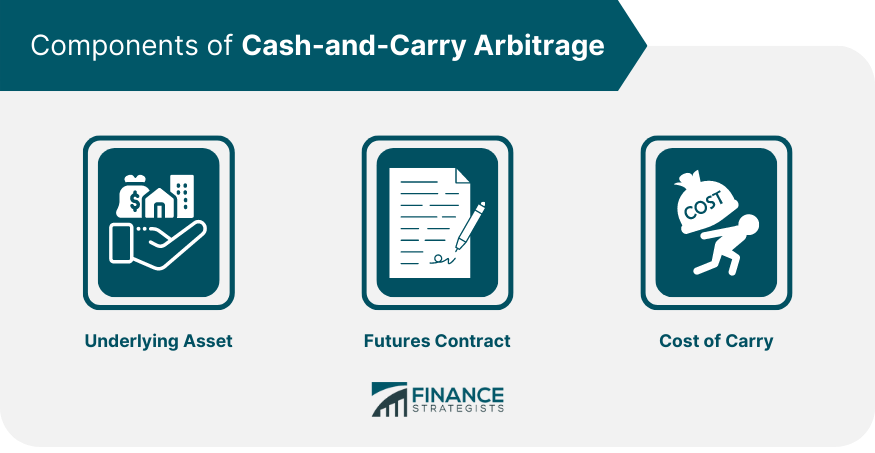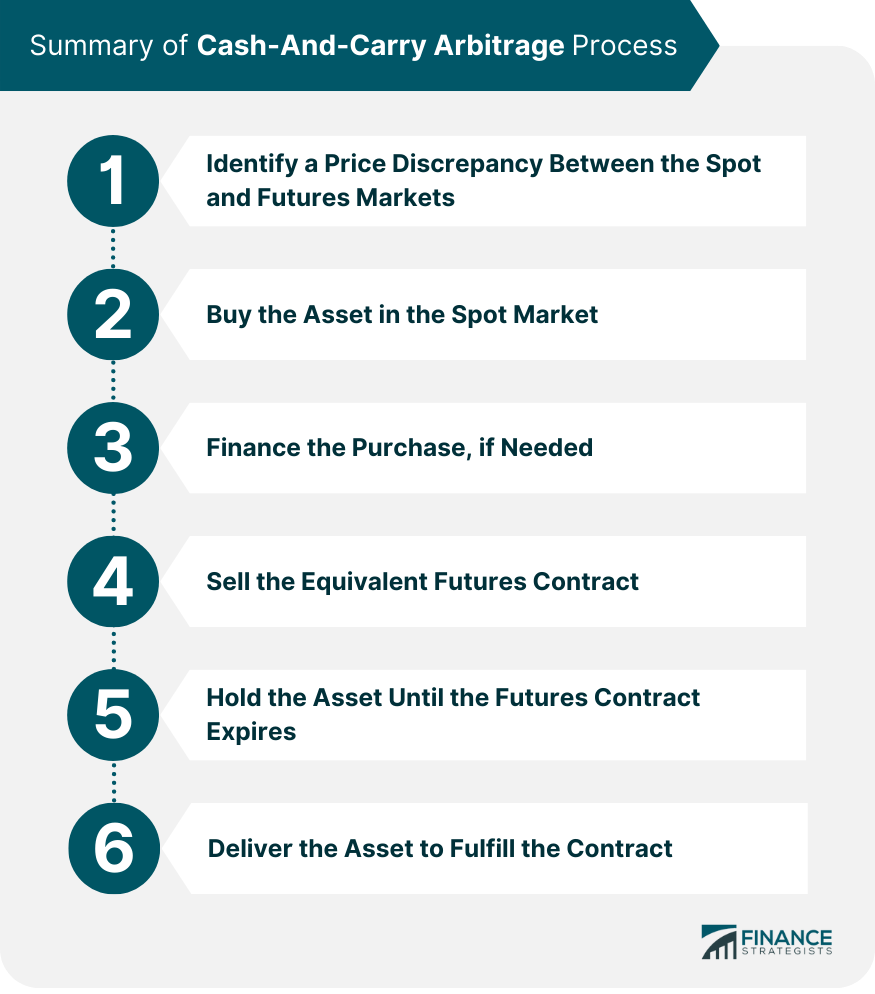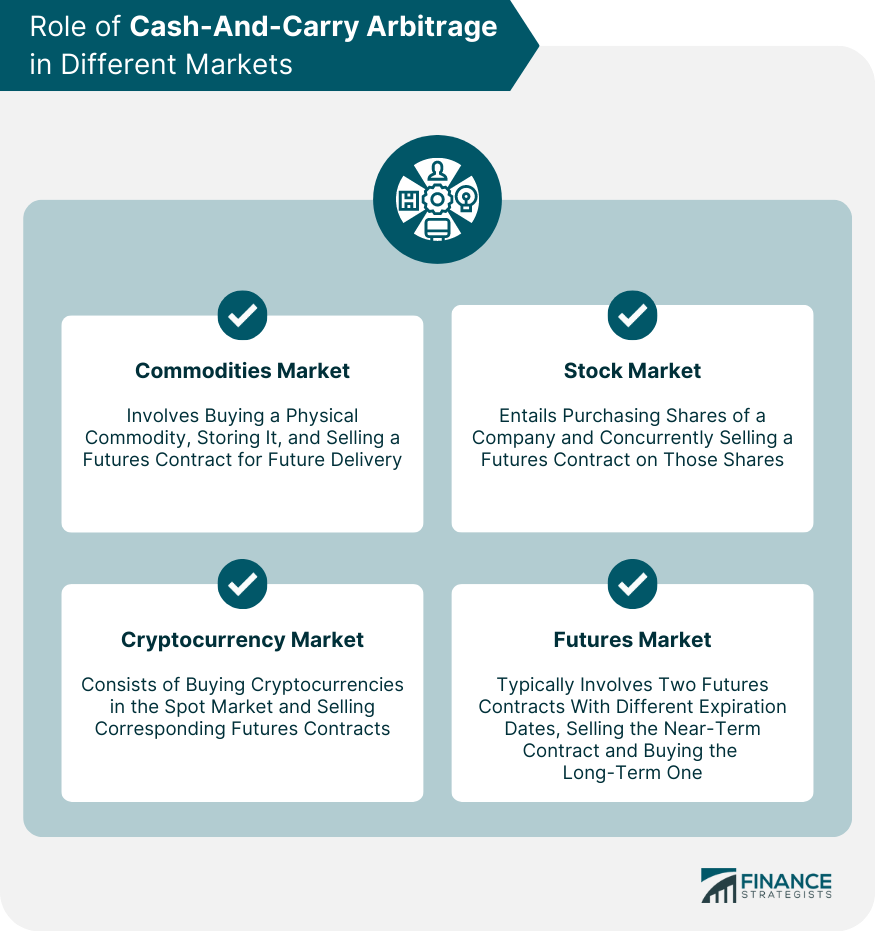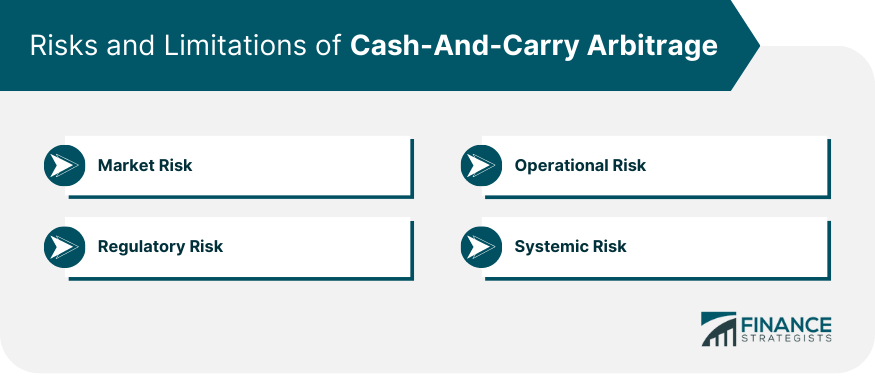Cash-and-carry arbitrage is a trading strategy that involves the simultaneous buying and selling of financial instruments to exploit price discrepancies in the market. The purpose of cash-and-carry arbitrage is to profit from temporary pricing inefficiencies between the cash market and the derivatives market. In cash-and-carry arbitrage, an investor purchases an underlying asset in the cash market and simultaneously sells a corresponding derivative contract, such as a futures contract or a forward contract. By doing so, the investor locks in a price difference between the cash and derivatives markets. Cash-and-carry arbitrage helps to ensure market efficiency by quickly correcting price discrepancies between the cash and derivatives markets. It also facilitates liquidity and promotes price discovery. However, as market participants engage in cash-and-carry arbitrage, the price discrepancies tend to diminish, making it a competitive strategy that requires quick execution and sophisticated risk management. The fundamental principle behind cash-and-carry arbitrage lies in the concept of the cost of carry. This represents the costs associated with holding an asset over a period, including storage costs, financing costs, and any income or yield earned from the asset. If the futures price is higher than the spot price plus the cost of carry, an arbitrage opportunity exists. The primary components involved in a cash-and-carry arbitrage strategy include the underlying asset, the equivalent futures contract, and the cost of carry. The underlying asset is purchased in the spot market, while the futures contract is sold in the futures market. The cost of carry is the cumulative cost of holding the asset until the futures contract expires. A cash-and-carry arbitrage strategy begins with the identification of a price discrepancy between the spot and futures markets for an asset. The next step is to buy the asset in the spot market, finance the purchase if necessary, and sell the equivalent futures contract. The trader then holds the asset until the expiration of the futures contract. Upon expiration, the asset is delivered, completing the arbitrage cycle. There are several key assumptions in cash-and-carry arbitrage. Firstly, markets are assumed to be efficient, and any price discrepancies are temporary. Secondly, the trader is assumed to have access to sufficient capital and the ability to borrow and lend at a risk-free rate. Lastly, it is assumed that the asset can be stored cost-effectively until the futures contract expires. In the commodities market, traders can use cash-and-carry arbitrage to profit from price differences between physical commodities and their corresponding futures contracts. This often involves buying a commodity, storing it, and selling a futures contract for delivery at a later date. In the stock market, cash-and-carry arbitrage involves buying shares of a company and simultaneously selling a futures contract on those shares. The arbitrageur aims to profit from any discrepancy between the stock price and the futures price. Cash-and-carry arbitrage has also found its place in the rapidly evolving cryptocurrency market. Traders can buy cryptocurrencies like Bitcoin in the spot market and sell futures contracts, aiming to exploit price discrepancies that may arise due to market volatility or liquidity issues. In the futures market, cash-and-carry arbitrage typically involves two futures contracts with different expiration dates. A trader could sell a near-term futures contract and buy a longer-term one, with the expectation that the price differential will narrow over time. The pricing model for cash-and-carry arbitrage is based on the relationship between the spot price, the futures price, and the cost of carry. In an efficient market, the futures price should equal the spot price plus the cost of carry. If this relationship does not hold, it indicates an arbitrage opportunity. The potential profit from a cash-and-carry arbitrage trade is calculated as the difference between the futures price and the sum of the spot price and the cost of carry. This profit is theoretically risk-free, provided the assumptions of the strategy hold true. While cash-and-carry arbitrage is often touted as a risk-free strategy, it's important to perform a thorough risk-reward analysis. This involves evaluating the potential profit against possible risks, including changes in market conditions, operational risks, and potential changes in the cost of carry. The mathematical model for cash-and-carry arbitrage assumes market efficiency and the ability to borrow and lend at a risk-free rate. These assumptions may not hold, leading to potential deviations from the model's predictions. Market risk refers to the risk of loss due to changes in market conditions. For example, unexpected changes in the spot price or the futures price could impact the profitability of a cash-and-carry arbitrage strategy. Operational risks include risks associated with trade execution, settlement, and other operational aspects. These risks can impact the successful execution of a cash-and-carry arbitrage strategy. Regulatory risk refers to the potential impact of changes in regulations on a trading strategy. For example, changes in margin requirements or trading rules could impact the viability of a cash-and-carry arbitrage strategy. Systemic risk refers to the risk of collapse of the entire financial system or market, which could impact the successful execution of a cash-and-carry arbitrage strategy. Cash-and-carry arbitrage is a trading strategy that exploits price discrepancies between the cash and derivatives markets. By buying an asset in the spot market and selling a corresponding futures contract, traders aim to profit from temporary pricing inefficiencies. This strategy helps ensure market efficiency, facilitates liquidity, and promotes price discovery. The key components of cash-and-carry arbitrage include the underlying asset, futures contract, and cost of carry. The process involves identifying price discrepancies, buying the asset, selling the futures contract, holding the asset until expiration, and delivering it to fulfill the contract. However, cash-and-carry arbitrage carries risks such as market, operational, regulatory, and systemic risks. Traders must perform risk-reward analysis and consider the limitations of the mathematical model to execute this strategy effectively.Cash-And-Carry Arbitrage Overview
Understanding the Cash-And-Carry Arbitrage Strategy
Basic Principle of the Cash-And-Carry Arbitrage
Components of Cash-And-Carry Arbitrage

Process Flow of Cash-And-Carry Arbitrage

Assumptions in Cash-And-Carry Arbitrage
Cash-And-Carry Arbitrage in Different Markets
Cash-And-Carry Arbitrage in the Commodities Market
Cash-And-Carry Arbitrage in the Stock Market
Cash-And-Carry Arbitrage in the Cryptocurrency Market
Cash-And-Carry Arbitrage in the Futures Market

Mathematical Framework of Cash-And-Carry Arbitrage
Pricing Model for Cash-And-Carry Arbitrage
Calculation of Potential Profits
Risk-Reward Analysis
Limitations of the Mathematical Model
Risks and Limitations of Cash-And-Carry Arbitrage
Market Risk in Cash-And-Carry Arbitrage
Operational Risk in Cash-And-Carry Arbitrage
Regulatory Risk in Cash-And-Carry Arbitrage
Systemic Risk in Cash-And-Carry Arbitrage

Bottom Line
Cash-And-Carry Arbitrage FAQs
Cash-and-carry arbitrage is a trading strategy that involves buying an asset in the spot market and simultaneously selling an equivalent futures contract to profit from price discrepancies between the two markets.
In the stock market, cash-and-carry arbitrage involves buying shares and simultaneously selling a futures contract on those shares. The aim is to profit from any discrepancy between the stock price and the futures price.
While cash-and-carry arbitrage is often considered a risk-free strategy, it does come with several risks. These include market risk, operational risk, regulatory risk, and systemic risk.
Technology plays a significant role in cash-and-carry arbitrage. Advances in data analytics and algorithmic trading have made it easier to identify and exploit arbitrage opportunities.
The future of cash-and-carry arbitrage is likely to be shaped by technological advancements, regulatory changes, and evolving market trends. These could include the increasing use of artificial intelligence in trading, changes in financial regulations, and the growth of decentralized finance.
True Tamplin is a published author, public speaker, CEO of UpDigital, and founder of Finance Strategists.
True is a Certified Educator in Personal Finance (CEPF®), author of The Handy Financial Ratios Guide, a member of the Society for Advancing Business Editing and Writing, contributes to his financial education site, Finance Strategists, and has spoken to various financial communities such as the CFA Institute, as well as university students like his Alma mater, Biola University, where he received a bachelor of science in business and data analytics.
To learn more about True, visit his personal website or view his author profiles on Amazon, Nasdaq and Forbes.













